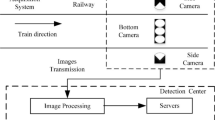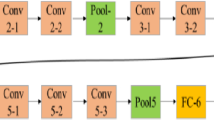Abstract
A safe and reliable avionics system is an important guarantee for airplanes when accomplishing all kinds of tasks. With the ever more comprehensive and intelligentized development of avionics system, the layout of cable brackets becomes more complicated, which results in the quick and reliable assembly, and inspection of cable brackets is becoming more and more demanding. Nowadays, the detection and recognition of cable brackets in aircraft assembly scenes still rely on manual labor to compare the real assembly scene with the designed two-dimensional drawings or graphs. With the increase in number and types of cable brackets, the recognition process in multi-assembly scenes becomes intricate, time-wasting, and highly mistakable. Aiming at the cable bracket recognition problems, this paper proposes a low retrain complexity hybrid model for adaptive recognition of cable brackets. Firstly, this paper builds a weight sharing feature extraction model using improved loss function and multi-scale ensemble convolutional neural network according to the analysis of cable brackets. Secondly, the support vector machine is used to classify the feature vector extracted by pre-trained feature extraction model. By this way, the hybrid model could be retrained quickly for new types of cable brackets never seen in multiple assembly scenes, under condition that bracket number and types are variable. At last, the performances of other feature extraction methods such as SIFT, HOG, and multi-layer perceptron (MLP) are evaluated for contrast with the proposed method. As shown in the results, our method obtains higher recognition accuracy.

















Similar content being viewed by others
References
Hana C, Parka S, Leeb H (2019) Intermittent failure in electrical interconnection of avionics system. Reliab Eng Syst Saf 185:61–71. https://doi.org/10.1016/j.ress.2018.12.016
Jing T, Zhang S, Shi X, Wang L.(2011) Design of aircraft cable fault diagnose and location system based on aircraft airworthiness requirement, The 2nd International Symposium on Aircraft Airworthiness (ISAA 2011) 17:455-464. https://doi.org/10.1016/j.proeng.2011.10.055
DiCicco W (1993) Repairable gas turbine electrical cable assemblies. The International Gas Turbine and Aeroengine Congress and Exposition. https://doi.org/10.1115/93-GT-048
Rierson LK (2010) Best practices for certifying IMA systems in civil aircraft. IEEE Aerosp Electron Syst Mag 25(1):4–8. https://doi.org/10.1109/MAES.2010.5442147
Bartley G, Lingberg B (2008) Certification concerns of integrated modular avionics (IMA) (IMA) systems. Digital Avionics Systems Conference. DASC 2008. IEEE/AIAA 27th. IEEE, 2008. https://doi.org/10.1109/DASC.2008.4702766
Sivaiah A (2012) Innovative bracket design concepts for the installation of aircraft systems. J Aerosp Technol Manag 4(3):289–295. https://doi.org/10.5028/jatm.2012.04030912
Mourtzis D, Zogopoulos V, Xanthi F (2019) Augmented reality application to support the assembly of highly customized products and to adapt to production re-scheduling. Int J Adv Manuf Technol 105:3899–3910. https://doi.org/10.1007/s00170-019-03941-6
Guo YJ, Dong HY, Wang GF, Ke YL (2018) A robotic boring system for intersection holes in aircraft assembly. Ind Robot 45(3):328–336. https://doi.org/10.1108/IR-09-2017-0176
Martinez,P;Ahmad,R;Al-Hussein,M.(2019) A vision-based system for pre-inspection of steel frame manufacturing. Autom Constr, 97:151-163. https://doi.org/10.1016/j.autcon.2018.10.021.
Yu C, Chen X, Xi JT (2018) Determination of optimal measurement configurations for self-calibrating a robotic visual inspection system with multiple point constraints. Int J Adv Manuf Technol 96(9-12):3365–3375. https://doi.org/10.1007/s00170-018-1739-x
Zhao DL, Kong FF, Du FZ (2019) Vision-based adaptive stereo measurement of pins on multi-type electrical connectors. Meas Sci Technol 30(10). https://doi.org/10.1088/1361-6501/ab198f
Delprete C, Rosso C, Savino G, Scarzella C (2017) Advanced vision approach applied to non-contact micro-measurements: a practical application. Int J Adv Manuf Technol 88(1-4):471–481. https://doi.org/10.1007/s00170-016-8755-5
Remeseiro B, Tarrio-Saavedra J, Francisco-Fernandez M, Penedo MG, Naya S, Cao R (2019) Automatic detection of defective crankshafts by image analysis and supervised classification. Int J Adv Manuf Technol 105(9):3761–3777. https://doi.org/10.1007/s00170-019-03819-7
Huynh TC, Park JH, Jung HJ, Kim JT (2019) Quasi-autonomous bolt-loosening detection method using vision-based deep learning and image processing. Autom Construct 105. https://doi.org/10.1016/j.autcon.2019.102844
Wang JJ, Fu PL, Gao RX (2019) Machine vision intelligence for product defect inspection based on deep learning and Hough transform. J Manuf Syst 51:52–60. https://doi.org/10.1016/j.jmsy.2019.03.002
Gonzalez-Navarro FF, Belanche-Munoz LA, Romero E, Vellido A, Julia-Sape M, Arus C (2010) Feature and model selection with discriminatory visualization for diagnostic classification of brain tumors. Neurocomputing 73(4-6):622–632. https://doi.org/10.1016/j.neucom.2009.07.018
Hinton GE, Salakhutdinov RR (2006) Reducing the dimensionality of data with neural networks. Science 313(5786):504–507. https://doi.org/10.1126/science.1127647
Levine S, Pastor P, Krizhevsky A et al (2018) Learning hand-eye coordination for robotic grasping with deep learning and large-scale data collection. Int J Robot Res 37(4-5):421–436. https://doi.org/10.1007/978-3-319-50115-4_16
Huang J, Kwok TH, Zhou C, Xu WY (2019) Surfel convolutional neural network for support detection in additive manufacturing. Int J Adv Manuf Technol 105(9):3593–3604. https://doi.org/10.1007/s00170-019-03792-1
Shuang K, Zhang ZX, Loo J, Su S (2020) Convolution–deconvolution word embedding: an end-to-end multi-prototype fusion embedding method for natural language processing. Inf Fusion 53:112–122. https://doi.org/10.1016/j.inffus.2019.06.009
Jung N, Lee G (2019) Automated classification of building information modeling (BIM) case studies by BIM use based on natural language processing (NLP) and unsupervised learning. Adv Eng Inf 41. https://doi.org/10.1016/j.aei.2019.04.007
Zhao R, Yan R, Chen ZH, Mao KZ, Wang P, Gao RX (2019) Deep learning and its applications to machine health monitoring. Mech Syst Signal Process 115:213–237. https://doi.org/10.1016/j.ymssp.2018.05.050
Tamilselvan P, Wang PF (2013) Failure diagnosis using deep belief learning based health state classification. Reliab Eng Syst Saf 15:124–135. https://doi.org/10.1016/j.ress.2013.02.022
Ambeshwar K, Manikandan R, Amir HG, Rizwan P, Szymon L, Ravichandran KS (2019) A deep neural network based classifier for brain tumor diagnosis. Appl Soft Comput 82. https://doi.org/10.1016/j.asoc.2019.105528
Kathalkar AA , Kawitkar RS, Chopade A (2013) Artificial neural network based brain cancer analysis and classification. Int J Comput Appl
Dai Y, Wang G (2018) A deep inference learning framework for healthcare. Pattern Recogn Lett 2018:S0167865518300448. https://doi.org/10.1016/j.patrec.2018.02.009
Fatemeh A, Antoine T, Marc T (2018) Tool condition monitoring using spectral subtraction and convolutional neural networks in milling process. Int J Adv Manuf Technol 98(9-12):3217–3227
Krizhevsky A, Sutskever I, Hinton G (2017) ImageNet classification with deep convolutional neural networks. Commun ACM 60(6):84–90
Xu X, Gao D, Zhou Y, Gao J (2020) Application of neural network algorithm in fault diagnosis of mechanical intelligence. Mech Syst Signal Process 141:106625. https://doi.org/10.1016/j.ymssp.2020.106625,
Yao Y, Wang N (2020) Fault diagnosis model of adaptive miniature circuit breaker based on fractal theory and probabilistic neural network. Mech Syst Signal Process 142:106772. https://doi.org/10.1016/j.ymssp.2020.106772
Wu Q, Lu X, Xue S, Wang C, Wu X, Fan J (2020) SBNN: Slimming binarized neural network. Neurocomputing 401:113–122. https://doi.org/10.1016/j.neucom.2020.03.030
Ren S, He K, Girshick R, Sun J (2017) Faster R-CNN: towards real-time object detection with region proposal networks. IEEE Trans Pattern Anal Mach Intell 39(6):1137–1149. https://doi.org/10.1109/TPAMI.2016.2577031
Simonyan K , Zisserman A (2014) Very deep convolutional networks for large-scale image recognition. Comput Sci
He K, Zhang X, Ren S, Sun J (2006) Deep residual learning for image recognition. 2016 IEEE Conference on Computer Vision and Pattern Recognition (CVPR). IEEE Comput Soc. https://doi.org/10.1109/CVPR.2016.90
Tsang IW, Kwok JT, Cheung PM (2005) Core vector machines: fast SVM training on very large data sets. J Mach Learn Res 6(2):363–392. https://doi.org/10.9774/GLEAF.978-1-909493-38-4_2
Funding
This research is funded by the Civil Airplane Technology Development Program (MJ-2017-G-70), and the Beijing Key Laboratory of Digital Design and Manufacturing Project.
Author information
Authors and Affiliations
Corresponding author
Additional information
Publisher’s note
Springer Nature remains neutral with regard to jurisdictional claims in published maps and institutional affiliations.
Rights and permissions
About this article
Cite this article
An, Z., Wang, Y., Zheng, L. et al. Adaptive recognition of intelligent inspection system for cable brackets in multiple assembly scenes. Int J Adv Manuf Technol 108, 3373–3389 (2020). https://doi.org/10.1007/s00170-020-05591-5
Received:
Accepted:
Published:
Issue Date:
DOI: https://doi.org/10.1007/s00170-020-05591-5




